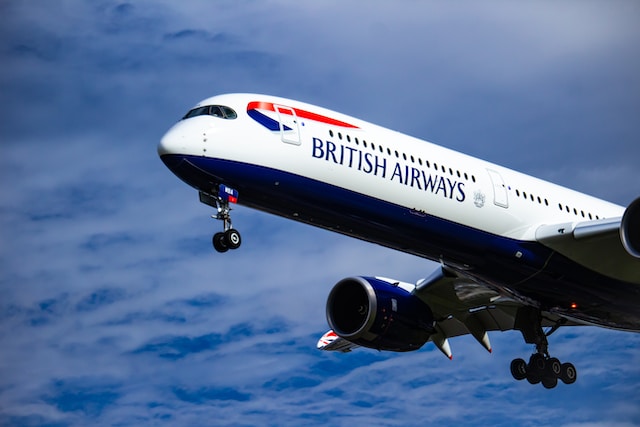Before we dive deep into the SWOT analysis, let us get the business overview of British Airways. British Airways (BA) is the flag carrier airline of the United Kingdom and one of the world’s leading airlines. It is headquartered in London, England, and has its central hub at London Heathrow Airport.
Founded in 1974 through the merger of four airlines, including British Overseas Airways Corporation (BOAC) and British European Airways (BEA), British Airways is a founding member of the Oneworld airline alliance, which was established in 1999.
In January 2011, British Airways merged with Iberia, creating the International Airlines Group (IAG), a holding company registered in Madrid, Spain. IAG is the world’s third-largest airline group in annual revenue and the second-largest in Europe.
Operating a fleet of wide-body and narrow-body aircraft, British Airways serves over 180 destinations across more than 80 countries worldwide. The airline offers a mix of domestic, short-haul, and long-haul services, catering to both business and leisure travelers.
British Airways’ business can be divided into several segments:
- Passenger Services: This is the core of BA’s operations, providing scheduled air transport services for passengers. The airline offers various cabin classes, including First Class, Club World (business class), World Traveller Plus (premium economy), and World Traveller (economy class).
- Cargo Services: British Airways World Cargo is responsible for transporting freight and mail on BA’s passenger aircraft. The cargo division serves a global network and offers various logistics solutions for customers.
- Loyalty Program: The British Airways Executive Club is the airline’s frequent flyer program, which allows members to earn and redeem Avios points for flights, upgrades, and other services. Members can also access partner services and benefits from Oneworld alliance members.
- Ancillary Services: BA offers a range of additional services, such as car rentals, hotel bookings, travel insurance, and airport lounge access, to enhance the overall travel experience for its customers.
Financial Performance: In 2022, British Airways generated 12.9 billion British pounds in revenue and 362 million British pounds in operating profits.
Here is a SWOT analysis for British Airways:
A SWOT analysis is a strategic planning tool used to evaluate the Strengths, Weaknesses, Opportunities, and Threats of a business, project, or individual. It involves identifying the internal and external factors that can affect a venture’s success or failure and analyzing them to develop a strategic plan. In this article, we do a SWOT Analysis of British Airways.
SWOT Analysis: Meaning, Importance, and Examples
Strengths
- Strong brand and reputation: British Airways has a long history and is an iconic brand recognized worldwide. As the UK’s flag carrier, it has a reputation for quality service and reliability, which helps attract both business and leisure travelers.
- Extensive route network: British Airways operates a wide range of domestic, short-haul, and long-haul flights, connecting passengers to over 180 destinations across over 80 countries. This extensive network allows the airline to offer convenient and efficient customer connections.
- Oneworld alliance membership: As a founding member of the Oneworld airline alliance, British Airways benefits from cooperation and partnerships with other leading global airlines. The alliance enables BA to offer a broader range of destinations, share resources, and provide its customers with additional benefits, such as access to partner lounges and the ability to earn and redeem loyalty points across member airlines.
- Modern and diverse fleet: British Airways operates a diverse fleet of aircraft, including fuel-efficient models like the Airbus A350 and Boeing 787 Dreamliner. Having a modern fleet helps the airline reduce operational costs, minimize its environmental impact, and offer a more comfortable experience for passengers.
- Strong loyalty program: The British Airways Executive Club is a popular and well-regarded frequent flyer program that encourages customer loyalty and repeat business. Members can earn and redeem Avios points for various rewards and benefits, including flights, upgrades, and partner services.
- Economies of scale and synergies: Being part of the International Airlines Group (IAG), which has brands like Iberia, Vueling, and Aer Lingus, enables British Airways to leverage economies of scale and benefit from synergies with other airlines. This helps to reduce costs, improve operational efficiency, and increase its competitive advantage.
- Strategic partnerships: British Airways has formed various code-sharing and joint venture agreements with other airlines, which help expand its network, increase market access, and share risks and resources.
- Premium customer experience: BA is known for its focus on delivering a high-quality travel experience, particularly for premium passengers. Offering premium services, such as exclusive airport lounges, personalized in-flight service, and luxury amenities, helps the airline differentiate itself from competitors and attract high-value customers.
Weaknesses
- Dependence on the UK market: British Airways relies heavily on the UK market, making it vulnerable to economic fluctuations and changes in consumer demand. Any downturn in the UK economy or shifts in travel patterns could negatively impact BA’s business.
- High operating costs: As a legacy carrier, British Airways faces high operating costs, including labor expenses, maintenance, and airport fees. These costs can make it challenging for the airline to compete with low-cost carriers that operate on a leaner cost structure.
- Labor relations: British Airways has faced labor disputes and strikes in the past, which can result in operational disruptions and harm its reputation. Maintaining positive labor relations is crucial for the airline to ensure smooth operations and customer satisfaction.
- Impact of external factors: Like other airlines, British Airways is susceptible to factors beyond its control, such as fluctuations in fuel prices, currency exchange rates, and global economic conditions. These factors can significantly impact the airline’s profitability and operational stability.
- Aging infrastructure: Some British Airways’ facilities, such as its primary hub at London Heathrow Airport, are aging and can result in capacity constraints and operational inefficiencies. Upgrading and expanding its infrastructure may require significant capital investments.
- Environmental concerns: The aviation industry is under increasing scrutiny for its environmental impact, and British Airways is no exception. Reducing emissions and minimizing its environmental footprint is becoming increasingly crucial for the airline to maintain its social license to operate and comply with emerging regulations.
- Competition from low-cost carriers: British Airways faces stiff competition from low-cost airlines, particularly on European short-haul routes. These carriers often offer significantly lower fares, which can pressure BA’s pricing and profitability.
Opportunities
- Expansion in emerging markets: British Airways can explore growth opportunities in emerging markets such as Asia, Africa, and Latin America, which are expected to see a significant increase in air travel demand in the coming years. Establishing new routes and partnerships in these regions can help diversify BA’s revenue streams and reduce its dependence on the UK market.
- Strengthening partnerships and alliances: British Airways can further leverage its Oneworld alliance membership and pursue strategic partnerships with other airlines to expand its network, share resources, and enhance its service offerings. This can help the airline offer better connectivity, increase market access, and improve cost efficiencies.
- Focus on digital transformation and innovation: Investing in digital transformation initiatives, such as enhancing its online booking platform, improving mobile app functionality, and leveraging data analytics for personalization, can help British Airways improve the customer experience, streamline operations, and increase revenue.
- Expanding ancillary revenue streams: British Airways can explore opportunities to grow its ancillary revenues, such as offering additional services like car rentals, hotel bookings, and travel insurance. This can help diversify BA’s income sources and improve its overall profitability.
- Sustainable aviation and environmental initiatives: British Airways can invest in sustainable aviation initiatives, such as adopting new aircraft technologies, exploring alternative fuels, and implementing carbon offset programs. The airline can enhance its reputation and comply with emerging regulations by demonstrating its commitment to reducing its environmental impact.
- Cost reduction and operational efficiency: British Airways can improve its cost structure and operational efficiency through fleet modernization, process optimization, and better resource management. This can help the airline to compete more effectively with low-cost carriers and improve its overall financial performance.
- Enhancing customer service and loyalty: British Airways can strengthen its brand reputation and customer loyalty by improving customer service and addressing issues that have led to negative publicity. Investing in employee training, customer feedback systems, and service recovery mechanisms can help the airline achieve this goal.
- Targeting niche markets and segments: British Airways can explore opportunities to cater to specific customer segments, such as premium travelers, business travelers, or passengers with special needs. By offering tailored products and services, the airline can differentiate itself from competitors and attract high-value customers.
Threats
- Intense competition: British Airways faces fierce competition from other full-service carriers, low-cost airlines, and alternative modes of transportation, such as high-speed rail. This competitive environment puts pressure on pricing, market share, and profitability.
- Economic fluctuations and geopolitical uncertainties: The airline industry is sensitive to global economic conditions and geopolitical events, which can affect travel demand and consumer spending. Economic downturns, political instability, or international conflicts could reduce air travel demand and impact British Airways’ business.
- Regulatory changes and compliance: Airlines are subject to various regulations and compliance requirements related to safety, security, and environmental standards. Changes in these regulations or introducing new rules could increase costs and operational challenges for British Airways.
- Fuel price volatility: Fuel costs are a significant expense for airlines, and fuel price fluctuations can substantially impact profitability. British Airways is exposed to the risk of rising fuel prices or disruptions in supply, which could negatively affect its financial performance.
- Labor disputes and workforce challenges: British Airways has faced labor disputes and strikes in the past, which can lead to operational disruptions and damage its reputation. Maintaining positive labor relations and addressing workforce challenges, such as employee retention and talent acquisition, is crucial for the airline’s success.
- Cybersecurity threats and data breaches: British Airways increasingly relies on digital systems for its operations and customer interactions, and the risk of cybersecurity threats and data breaches becomes more significant. Any such incidents could result in financial losses, regulatory penalties, and damage to the airline’s reputation.
- Health crises and pandemics: The COVID-19 pandemic has shown that global health crises can severely impact the airline industry. British Airways may face similar threats in the future, which could lead to travel restrictions, reduced demand, and operational challenges. British Airways’ revenue declined by 75% in 2020 and 2021 due to the pandemic.
- Climate change and environmental concerns: The aviation industry is under scrutiny for its environmental impact, with increasing pressure from governments, regulators, and the public to reduce emissions and mitigate climate change. This could lead to new regulations, taxes, or operational restrictions that could negatively impact British Airways’ business.
- Currency fluctuations: As a global airline, British Airways is exposed to the risk of currency fluctuations, which can affect its revenue and profitability. Changes in exchange rates could result in increased costs or reduced earnings, depending on the currency movements.









